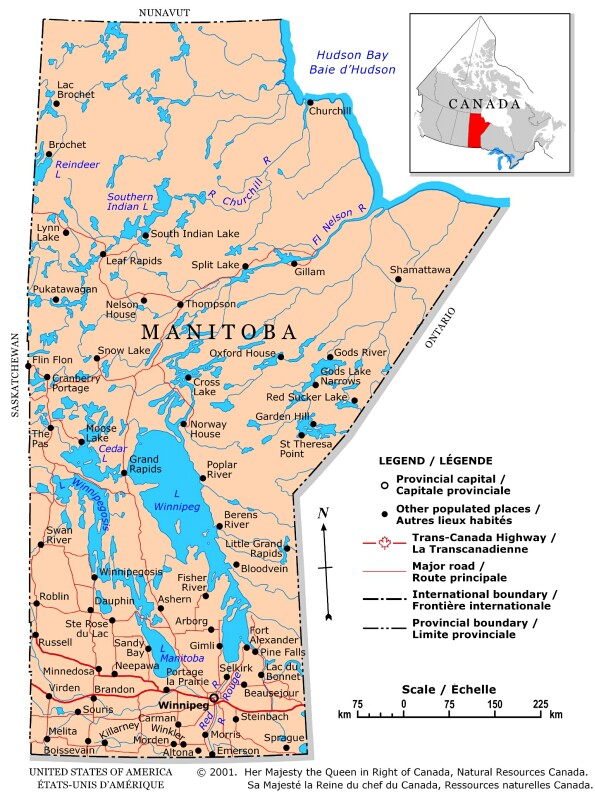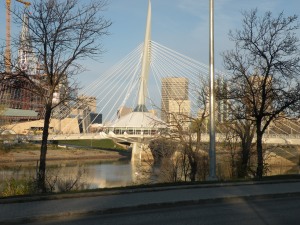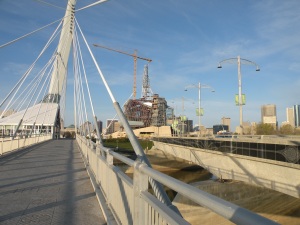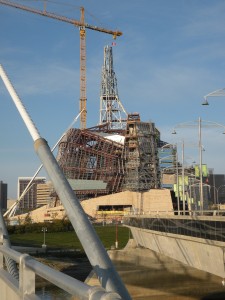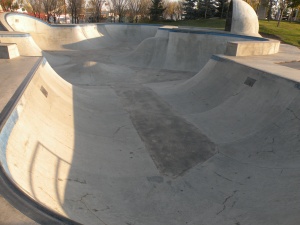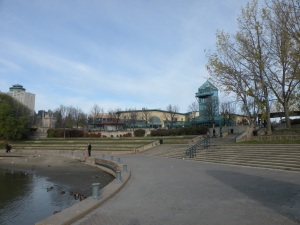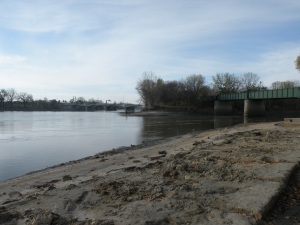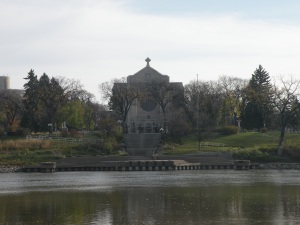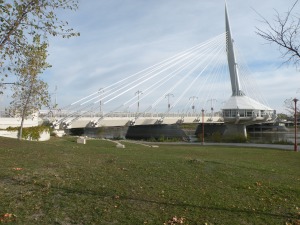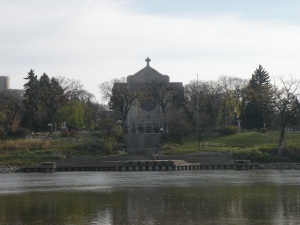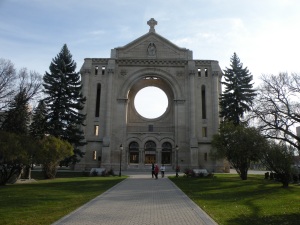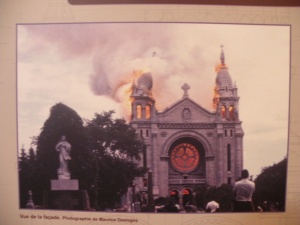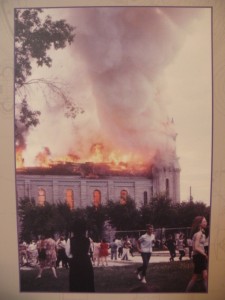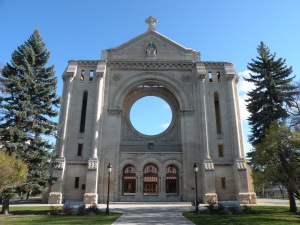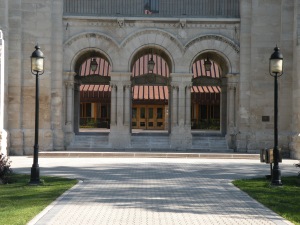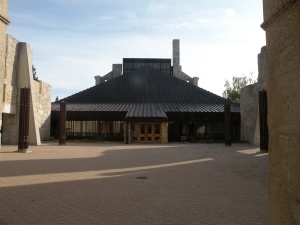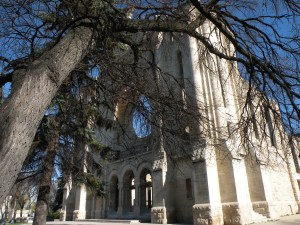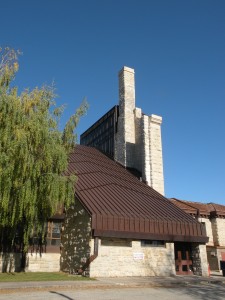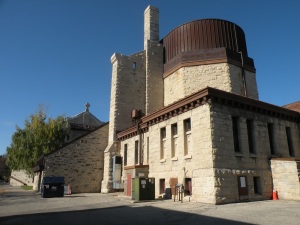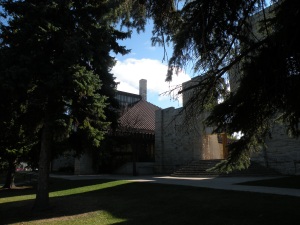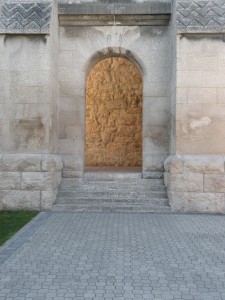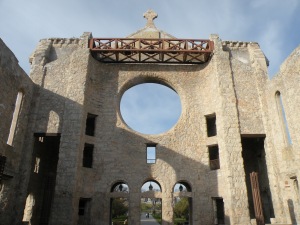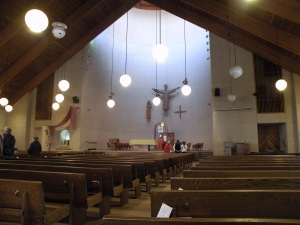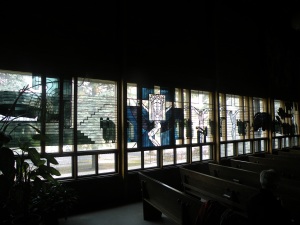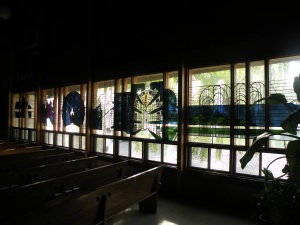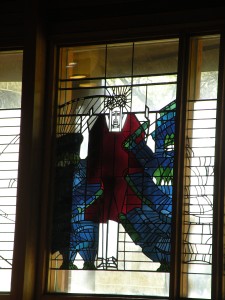The day broke sunny and crisp in St. Boniface, the original French foundation of the city of Winnipeg on the eastern shore of the Red River. The day was going to be a day of learning.
Geography and History — The former Social Studies teacher in me cannot resist sharing some geographical and historical perspective which might be helpful for those readers from the States (about 99.9% of all the readers of this blog).
Bordering North Dakota and Minnesota on the south, with Ontario east and Saskatchewan west, Manitoba is (as most of the western provinces of Canada) massive. It encompasses 647,797 square kilometers (250,116 square miles), with a population (2006 Census) of 1,148,401 (Source: Statistics Canada). Known as the “The Land of 100,000 Lakes”, these many waters flow within the vastness of the prairie (the province is table-top flat).
The modern nation of Canada (itself a part of the British Empire; Elizabeth II is their Queen) comprises 10 provinces and 3 territories. Spanning over 9.9 million square kilometres (6.151 million square miles) of which 891,000 square kilometres are water, it is the world’s second largest country by total area, sharing with the United States the largest land border in the world.
Like all the “Americas”, the first to inhabit this land were aboriginal tribes and their civilizations. The Vikings made a brief foray to the eastern shores circa 1000 C.E. (Christian, or Common Era). Beginning in the 15th Century European explorers came: first, John Cabot (English, 1497), followed by the French explorers Jacque Cartier (1534) and Samuel de Champlain (1603). From among the French who began to settle these newly discovered lands came the voyageurs, buffalo hunters and fur trappers working for the Hudson Bay Company. In time, they met, interacted with, and in many cases, married peoples of the First Nations (aboriginal tribes, Cree, Sioux, among others).
When France was defeated by England in the French and Indian War, the Treaty of Paris passed all the northern French colonies to England (1763). From that point forward the life of these peoples mixed into what would one day become “The Confederation” and eventually, the “Dominion of Canada” (1867).
The Province of Manitoba entered the Confederation on July 15, 1870, through the leadership of Louis Riel (a Metis — descendent of mixed blood, French and First Nation) who would play a pivotal role in the history of Saskatchewan as well.
What would become the capital, Winnipeg, began as an aboriginal gathering area at the confluence of the Assiniboine and Red Rivers. The Metis, drawn as the aboriginal peoples to this natural gathering, founded within sight of this natural flowing of waters the area of St. Boniface (now a part of Winnipeg). As a French based settlement, it grew and flourished, expanding its influence west and north. In time, the entire area of Manitoba became for these French-speaking Catholics the Diocese, then the Archdiocese, of St.Boniface.
In 1916, the Archdiocese of Winnipeg was created from the western portion of St. Boniface (a change brought about by concerns of the English-speaking Irish population who wished to have more of an identity outside of the predominant French-speaking St. Boniface).
Today the Archdiocese of St. Boniface encompasses the eastern portion of the city of Winnipeg, continues south below the Assiniboine River to a point where an artificial line drops south to the border with North Dakota and Minnesota. The eastern boundary is shared with the Province of Ontario, and continues north to an artificial line cutting west somewhere between Beren River and Poplar River on the shore of Lake Winnipeg. Thus St. Boniface is, cartographically speaking, an “L” laid backwards.
My friend, Archbishop Albert LeGatt, has served the Archdiocese of St. Boniface since 2009. He came to Winnipeg from being the Bishop of Saskatoon in Saskatchewan (2001 – 2009), and prior a priest and native son of the Diocese of Prince Albert, Saskatchewan.
Saturday Morning – We saw each other at breakfast, both having slept well, thank God. Albert had an important pastoral meeting away, which left me to wander on foot the area.
The Archbishop’s House and Cathedral complex sit on the eastern bank of the Red River, just south where the former meets the Assiniboine River. It was to this juncture that I set out.
Known as “The Forks” (La Fourche), this park area is central to the history of Winnipeg / St. Boniface as the aboriginal gathering area in use for over 6,000 years. Access from St. Boniface is over an artistically designed suspension footbridge.
Looming large, as one crosses the walkway, soars the Canadian Museum for Human Rights, still under construction.
Briefly overcome by the immensity of this construction project, and forced to contemplate a museum dedicated to such focus — not only its importance but its broad sweep for all humanity — I lingered in admiration.
The brisk, biting west wind did cut through my reverie, inviting me to amble further into the park. Another artifact of adolescent daring and freedom quickly loomed — a roller blade / skateboard arena!
There was a lone boarder in the park. I cannot imagine his delight to have such a facility at hand and under board!
Moving west, the park continued to unfold in open spaces, and eventually larger structures housing shops.
I found within the shops a large variety of eateries and shops — Thai, Chinese, Canadian, Pancake House with French crepes, gelato and smoothie; ceramic, crystal, jewelry, comic book, leather, hand-woven goods, and of course, a “Canada” store. I’m not much of a shopper, but the fruit smoothie proved awfully good, and letting it warm up a bit outside lead me to roam many of the shops looking for bargains (I found no such to my taste, but did find a fine gift for a friend).
Braving what I hoped was warmer air (it was), I set out along the shore of the Assiniboine River toward its confluence with the Red River.
I walked along the river bank walkway back toward the suspension walkway. The sites along and across the river were impressive.

English portion (with First Nation, then French, below) of plaque describing history and importance of the Red River, Winnipeg
The river walk showed much evidence of the floods of the spring and summer along the Red and Assiniboine Rivers, with the muddy water line a good 20 feet above my head, and large drift logs yet pinned at the top of the pylon supporting the suspension walkway. If not for the flood-control ditch (dug around the city of Winnipeg after the mammoth 1950 flood), the city would have suffered great damage this year. As it was, the city just got to see a lot of water leave behind its markings and mud!
It would be quite a flood if waters were to reach the Cathedral of St. Boniface. Upon the eastern bank of the Red River, the cathedral rises majestically, nestled amidst trees and fronted by Tache Avenue and the Cemetery of St. Boniface.
From a distance and in the proper light, one easily imagines an impressive interior of the cathedral based upon what one sees of the impressive exterior. From 1905 until July 22, 1968, it would have been possible to match vision of exterior to interior. But that day a disastrous fire broke out amidst some maintenance work on the roof, and within hours the roof, bells, and entire interior save the sacristy area were destroyed.
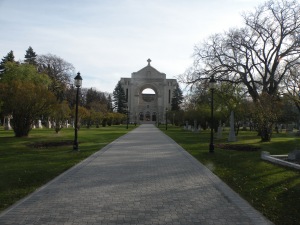
Facade of the Cathedral of St. Boniface, set amidst the Cemetery of St. Boniface. Note sky and bisecting roof line in the midst of the rose window frame.
Legend has the phoenix rise from the ashes. What rose amidst the charred walls and now empty interior of the cathedral is the sixth structure so named for St. Boniface. Completed in 1971, the visionaries who conceived it incorporated large portions of the exterior walls and the surviving sacristy area into this gathering place of worship for the people and their bishop of the Archdiocese of St. Boniface. The plaza leading up to the new cathedral is nestled amidst the walls. The recast bells are hung upon the interior of the facade. The remains of the deceased bishops and other clerics attached to the history are buried in what were the bell towers. Let the pictures below tell the story.
What of the interior of the 1971 cathedral? Definitely (and purposefully, I was told) smaller than before; modern in its sweep (yes, a period piece from the 8th decade of the twentieth century); warm and inviting to one who would be in solitary prayer or gathered for Eucharist with bishop, priests, deacons and laity — the Church embodied and most itself in such a moment.
I would have taken more photos, but a confirmation class with their parents had arrived; they were waiting for Archbishop Albert. One of his scheduled events of the day which he invited me to share, I eagerly anticipated his teaching these young folk (middle school) about cathedral, bishop and church! The night before he had spoken enthusiastically of such moments and how he delights in this interaction and the students’ reactions!
Well, we waited. And waited. An adult lay catechist, who works with Archbishop Albert for such events, did explain that he could well be detained. We waited. Then, the catechist’s cell phone chirped; it was he; he would be detained longer, but would meet the group at the Archbishop’s House. The catechist, explaining to us the situation, proceeded to deliver a walk-around and very credible explanation of the life and history of the Archdiocese, how and whom it serves, and a few aspects of what an Archbishop does (leaving enough unsaid for the Archbishop across the way!)
By now, it was about noon. Time for lunch! I discreetly left the catechist, parents and students, returning to the Archbishop’s House. Finding the dining room and a number of the residents already eating, I joined them for a warm and spirited conversation.
Knowing it could be awhile before Albert was free, I returned to my room to read.

